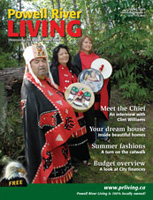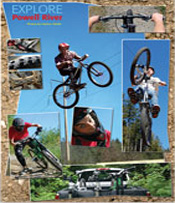June 2009
>> This entire issue is available as a 12MB PDF download
Table of Contents
Publisher's Message: Get outside and enjoy the weather
Kudos
From gold in Seoul to gold at Whistler
Benefit concerts
Drumming and singing: Spirit Singers help revive culture
Fashion for everyone
Building their dream house
A blissful summer retreat
Profile of a Chief: Meet Tla‘amin Chief Clint Williams
Amish Gah: Let’s go! fitness program
Time to plant
Nettles: Amazing plant is worth the sting
Pardon My Pen
Powell River Pugilism
Business Connections
Family Matters
Point of VIU
For Art's Sake
What is it with the weather?
Planning to sell your house? Make it look good
Flying and Fly-ins
Clansmen Pipe Band
Moose Club alive and well
Locally created and managed portal
Henderson means heritage and heart
Explore Powell River
Publisher's Message
Get outside and enjoy the weather
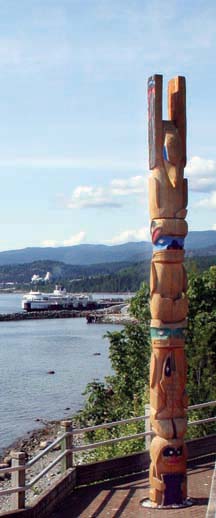 It is so hard to work when the sun is shining and the warm winds of spring are beckoning. It’s a beautiful Saturday afternoon and I am having a hard time focusing on writing this piece when all I want to do is go play outside!
It is so hard to work when the sun is shining and the warm winds of spring are beckoning. It’s a beautiful Saturday afternoon and I am having a hard time focusing on writing this piece when all I want to do is go play outside!
There are so many distractions at this time of year. Anyone who has kids still in school know that the month of June is filled with all kinds of activities and end-of-the-year stuff you simply must attend. It’s a great time for biking, for camping, for hiking and doing all those wonderful outdoor activities our region has to offer.
Before I lose myself to the great outdoors again let me tell what’s In This Issue.
To begin with, we have a couple of stories about beautiful homes. These pictures will inspire you to think about new decorating ideas and have you making plans to start sprucing up your own home!
Our photographers attended three fashion shows last month and our creative guy has done a fabulous job of showing the diversity of fashion viewed through a lens.
With National Aboriginal Day coming up soon, on June 21, we thought it fitting to include a some pieces about Sliammon First Nation. There’s profile of Chief Clint Williams; a story about the Spirit Singers, plus a short piece about a new get fit program that’s already making a difference for participants at Sliammon.
We have a gardening story by horticulturist Jonathan Van Wiltenburg (who, incidentally, is also now the proud owner of a very cute Nova Scotia Duck Tolling Retriever puppy) and a fascinating story about a wild nettle walk.
Besides our regular columns, we have a story about a motivational speaker who recently won a huge public speaking contest for all of BC. Claude Poumerol’s story about overcoming adversity is truly inspirational and we wish her luck in her next contest.
There’s a follow up to a story about the Moose Lodge which we published a couple of months ago. It talks about what is happening now at the building. Since the writing of that piece, long time Moose member Arnold Carlson, former mayor, councillor and businessman, passed away last month. His celebration of life was packed as people came to pay tribute to a man who gave so much to this community.
The great outdoors is beckoning, can’t you hear it? Yes, there are lots of jobs to be done but at this time of year it is far more fun to focus on the outside jobs than the inside jobs and if you can’t think of any outside work to do there’s always the garden! Digging and planting is a wonderful way to relieve stress and reconnect to Mother Nature.
Isabelle Southcott, Publisher • isabelle@prliving.ca
Running hero
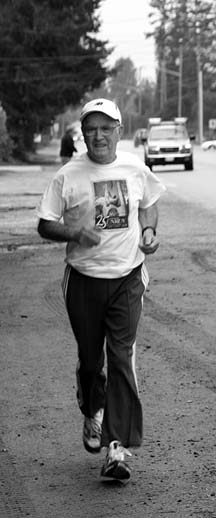 Congratulations to Roger Taylor for running his 22nd Vancouver Sun Run in April. Taylor, 88, finished ninth in his category. Taylor began running in 1966 at the age of 46. He says he put on weight after getting married and had to give up swimming and diving because the chlorine bothered him. “Someone suggested I take up jogging and then I did a 10K run.”
Congratulations to Roger Taylor for running his 22nd Vancouver Sun Run in April. Taylor, 88, finished ninth in his category. Taylor began running in 1966 at the age of 46. He says he put on weight after getting married and had to give up swimming and diving because the chlorine bothered him. “Someone suggested I take up jogging and then I did a 10K run.”
Taylor first did the Sun Run in 1985, his first marathon the same year and 24 marathons later he decided to run the Boston Marathon. “I ran it and it was really the highlight of my running career.”
If you are looking for an 88-year-old man to talk to about running, you’ll have to look hard as Taylor looks much younger than he is. In fact, I passed by him twice at our meeting place of Edgehill Store and had to have someone point him out!
Taylor jogs five times a week, hikes with the Bomb Squad and has applied to be a torchbearer for the 2010 Olympics.
“As long as I’m capable and can handle it I’ll keep running!”
Mom on the run
Way to go Christine Behan for running the Boston Marathon on April 20 with 23,000 other runners! This one is called the granddaddy of all marathons and runners must first qualify to run.
Christine, a busy mother of three, only began running 2½ years ago. She did the Boston in 3:46 and says she didn’t think she had done anything special. “So many people have called me to talk about it!” she told Powell River Living.
Now that she isn’t training for a marathon Christine, has more time to go running with her boys.
Sounds pretty special to us. Great time and what an inspiration to get us off the couch!
Francophone singer wins award
 Powell River chanteuse Josée Allard and her girl group Leoffenders won the Radio-Canada Musiklip 2009 contest with their song Demain.
Powell River chanteuse Josée Allard and her girl group Leoffenders won the Radio-Canada Musiklip 2009 contest with their song Demain.
Josée, who was born here in 1981, was part of the volleyball dynasty in Powell River coached by Doug Skinner, and sang in a local choir taught by Ms. Harris.
Josée’s second album, La Sirene, was recorded in Victoria, and released in June 2008 in Vancouver, was amongst the outstanding francophone music nominated at the 2008 WCMA in Edmonton.
The band Leoffenders came together in the fall of 2008, soon after the end of a spring tour Femme en Chanson. They’re currently being featured in showcase of Western Canada’s francophone artists called Operation Chanson. Though there’s no word about a Powell River visit, she played the Patricia in 2004 and Evergreen 2005, “so it’s only a matter of time before she comes back with all she’s got, whether we’re ready or not,” says publicist Lise Allard.
Check out www.leoffenders.com to get the latest on the band. The Powell River Library has a copy of this CD to lend and it is for sale at the Club Bon Acceuil (French Club on Manson Ave) and at l’École Côte du Soleil.
Thanks, Assumption
Congratulations to Assumption School! Not only did their Spring Fling Concert fill the ocean air at Willingdon Beach with great music, but they passed the hat to help raise funds for Therapeutic Riding. Thanks to all the great performers and to those who made donations.
From gold in Seoul to gold at Whistler
Champion runner and speaker competing again
By Isabelle Southcott
Claude Poumerol was twice as old as her competitors when she set the world record for the 100-metre dash at the 1988 Seoul Paralympics and won the gold medal. On that day, she accomplished a goal she set when she was a 15-year-old girl living in Paris.
Claude recently moved to Powell River and joined Powell River Sunshine Speakers Toastmasters. She won the International Speech Competition for District 21 Toastmasters in Whistler on May 16 and this month she advances to compete at the regional contest in Oakland, California.
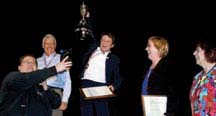 Claude first joined Toastmasters in 1988 and was a member for 10 years before moving overseas. When she returned to Vancouver earlier this year, she rejoined the international organization. “The second week I was there someone said we need a contestant for the International Speech Contest and I didn’t see any hands coming up so I said: ‘I will, and I raised my hand.’”
Claude first joined Toastmasters in 1988 and was a member for 10 years before moving overseas. When she returned to Vancouver earlier this year, she rejoined the international organization. “The second week I was there someone said we need a contestant for the International Speech Contest and I didn’t see any hands coming up so I said: ‘I will, and I raised my hand.’”
Claude won the club competition, then won the area competition. She won the division competition and she won the region.
“I didn’t think I was going to get that far. I entered to make friends and I ended up winning.”
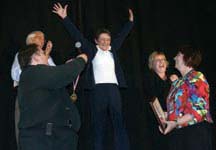 Claude’s winning speech, How I achieved my life goal in 15 seconds, is about the importance of having a dream. In Claude’s case, her dream was to be the fastest runner in the world.
Claude’s winning speech, How I achieved my life goal in 15 seconds, is about the importance of having a dream. In Claude’s case, her dream was to be the fastest runner in the world.
Claude grew up in Paris and when she was 15, she entered her first race. “I had no coach, no support and not even the proper running gear.” She went on to win that race and to become the youngest member of France’s Olympic Team going to Tokyo in 1964.
Ten days before the Olympic race Claude went for a drive with her father and they were hit by a drunk driver. Her father was killed and Claude woke up four months later. “They didn’t think I was going to make it,” she recalls. Claude was in a body cast, had a head injury, leg injuries, a ruptured spleen, and broken arms. It took firefighters three hours to get her out of the car.
“It was goodbye father, goodbye running, goodbye Olympics and goodbye life, I even thought. But life goes on,” she said.
Claude graduated from La Sorbonne University and taught at the prestigious Louis Pasteur College in Paris. She worked as an educator of the hearing impaired and as a pioneer teacher of Down’s Syndrome students in mainstream classes.
In 1968 she moved to Canada, to Montreal at first but she couldn’t understand their French, so she moved on to Calgary. There she met her husband, married and had her first child. The couple lived in Nanaimo, where she had her second child, and then they moved to Vancouver.
Claude shelved her dream of running after the car accident because her damaged leg had been left shorter than the other one and it was awkward.
In 1986, she learned she had cancer in her left leg and it was amputated just below the knee. She was fitted with a prosthetic leg. A few months after the operation, she was on the beach with her children and her son Steve said: “Come on Mom, get the ball.” It was then that Claude discovered she could run again.
“I automatically went running for the ball and I thought, ‘I can do it!’ and I started running again.”
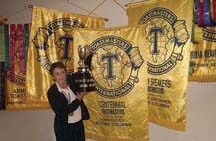 Claude joined the amputee sport association and began training. She went to the provincials, the nationals, the Commonwealth and then the Pan Am World Games and finally the Paralympics. In 1988, in Seoul, Korea, Claude won a gold medal for Canada in the 100-metre dash and set a new world record. She also won silver in the 200-metre sprint.
Claude joined the amputee sport association and began training. She went to the provincials, the nationals, the Commonwealth and then the Pan Am World Games and finally the Paralympics. In 1988, in Seoul, Korea, Claude won a gold medal for Canada in the 100-metre dash and set a new world record. She also won silver in the 200-metre sprint.
“I was the oldest at 40. I ran against 19 and 20 year olds.”
Was it easy? “Nothing was easy but everything was possible.”
Claude concluded her winning speech by saying: “If you have a dream, if you have a goal, don’t give up. If you don’t have a dream, make one. You have to have one. Otherwise, why else on earth do you get up in the morning?”
Now it’s on to Claude’s next Olympics—the Olympics of public speaking. Claude achieved her dream before and she’s determined to do so again. “I am going there as a winner,” she says. “I am going to do my very best. I will, I have to, I must, I know I can. If I got that far I know I can… just a little further, just one more obstacle.”
By the people, for the people. A group of people has been inspired to help the most vulnerable among us, our young children, who require the services of Family Place.
“By raising funds through large-scale benefit-concert productions, we can assure Family Place that badly needed resources will be provided without sacrifice,” says Jürgen Koppen, who recently formed Blue Healer Productions to do just that.
“Blue Healer Productions invites every one to be a concert co-producer. The idea is simple: bring in world-class performers, such as the Moody Blues and sell out the concerts.”
To bring in such stellar acts, solid production funds must be found. “While it is expensive to hire bands of such calibre, sold-out venues are practically guaranteed, with a great return for our beneficiary. If 2,000 people and businesses within the community are inspired to contribute $100 or more to the Blue Healer Trust Fund, this can happen,” said Koppen.
“A group like the Moody Blues can easily pull in 6,000 or 7,000 people from our area if Sechelt, Comox, Courtenay and the nearby islands are included,” he added. Check out www.cedar-strip.com/bluehealer for more information.
Drumming and singing
Spirit Singers help revive culture
By Cyndi Pallen (Chennay)
The Spirit Singers were created in 2000 as the result of a government initiative to assist First Nations people heal from the legacy of residential school.
 The legacy of residential school meant that many of the traditional ways of life became fragmented as First Nations people suffered many losses of language, identity, traditional and cultural teachings, parenting, hunting, and basic everyday livelihood as indigenous people.
The legacy of residential school meant that many of the traditional ways of life became fragmented as First Nations people suffered many losses of language, identity, traditional and cultural teachings, parenting, hunting, and basic everyday livelihood as indigenous people.
When Tla’amin Health Services implemented the Restoring Balance program, frontline workers began developing a plan to revive the spirit that included both contemporary counselling along with incorporating traditional values and cultural teachings as part of the projects. One of the plans was to bring in drummers and singers to teach community members the art of making drums and to further develop skills around using the language and to compose songs along with drumming and singing.
Aaron Nelson Moody of Squamish and Gerry Oleman from Lillooet came to teach our first class in Sliammon. Aaron passed on the Feast Song from Squamish Nation to Sliammon. The song was translated into the Tla’amin language. This was a very rewarding and moving experience in reviving a cultural practice that was diminishing. This was a turning point for me to keep learning and composing songs reflective of Tla’amin people.
The early Spirit Singers included Leanne Paul, Nona Harry, Andrea Waters (Mohawk) and youths Lucinda Louie, Brandi Francis, Lisa Williams, Jasmine Menendez and Julia Menendez.
Through the next years we had Adeline August, Wendy Debruin, Ramona Dominic, Joe Jr Paul, Charlie Bob and Brandi Harry
It takes time and commitment to practice and many of the community members have either moved or have other obligations. Today the most involved have been three prevalent singers: Cyndi Pallen–Chennay; Dawna Pallen–Pelnik; and Phillip George–Ahsheelth.
There were two significant elders assisting with language and support: Dad Joe D Paul, Chega gee muix, and Mary George. Both of these elders passed on to the spirit world in the last year. These elders played a big role and were one of the greatest supports. They participated with the Spirit Singers and attended all the functions, celebrations, and participated in all the events Spirit Singer’s performed at.

It was my parent’s teachings that helped me incorporate cultural teachings, and language and along with contemporary teaching to reviving the spirit of drumming and singing.
Fashion for everyone
Something old, something new
Photos by Isabelle Southcott & Hanlon Oldale
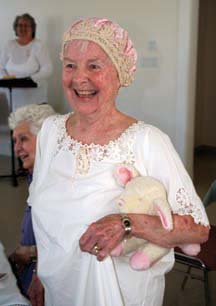 May was the month of fashion shows and Powell River Living took in three very different shows to learn what people in this fair community like to wear.
May was the month of fashion shows and Powell River Living took in three very different shows to learn what people in this fair community like to wear.
First off was a fashion show put on by the Powell River Museum as part of a special tea put on by the local Order of the Eastern Star. Models wore dresses from the 1930s, a party dress from a New Year’s Eve dance in 1950, a swim suit and hat worn in the 1950s, a pink silk night cap worn in the 1920s, an elegant graduation dress worn to the 30th graduating class of Brooks High School in 1957 and even a vintage Brooks School cheerleader uniform.
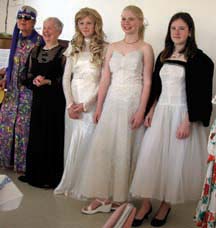
Brooks Graduation Grads fashion show saw some of Powell River’s trendiest and latest spring and summer fashions for teens from Armitage Men’s Wear, Dragonflyz, The Knack, Bootlegger and Fits to a T.

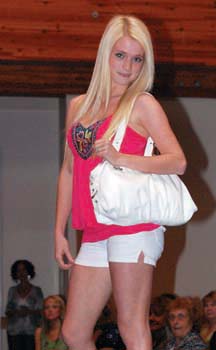
Last, but not least, was the Special Olympics Fashion Show hosted by Centsibles. Models wore outfits of their choice, which ranged from swimwear to mountain climbing garb and to doctors gear. Topping this great evening off was a wedding proposal made by PRACL employee Bill Hopkins to his beloved who said YES!
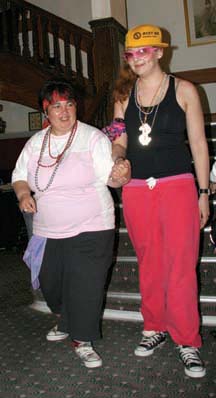
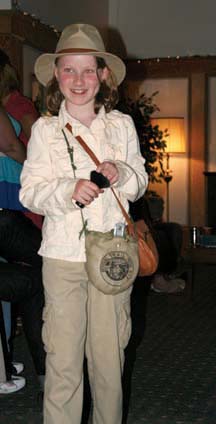
Building their dream house
How to understand your home intimately
By Isabelle Southcott
Building a house is a fabulous learning opportunity especially when you act as your own general contractor.
 Liechen and Steyn Naude hired Wes Brown Contracting to build their new home in 2007, Liechen assumed the role of general contractor. It was her first time in this role, in fact Liechen didn’t know much about construction at all. But Liechen had other skills that helped her tremendously and she drew on those skills constantly.
Liechen and Steyn Naude hired Wes Brown Contracting to build their new home in 2007, Liechen assumed the role of general contractor. It was her first time in this role, in fact Liechen didn’t know much about construction at all. But Liechen had other skills that helped her tremendously and she drew on those skills constantly.
Liechen is a lawyer and so her negotiating skills are highly developed. Her passion for decorating and design and keen organizational skills enabled her to keep contractors on track and reorganize when necessary.
A general contractor hires the trades people and coordinates their schedules. “That’s the toughest thing because if they get behind on the job everything starts to snowball,” she said.
It was a full time job, says Liechen. “I find it hard to imagine that people who are working can take on the job of general contractor.”
Many of the trades people encouraged Liechen to work alongside of them and showed her how to do things. “The insulation guys told me how I could put insulation in. Having hands on experience in building was fun.”
 Building the family dream home was something Liechen had wanted to do for a long time. Their daughter Kristin’s bedroom is beautifully decorated for a princess with pink and white and surprising finishing touches. Juanre, their hockey player son, chose a hockey theme for his room and the Vancouver Canucks reign supreme.
Building the family dream home was something Liechen had wanted to do for a long time. Their daughter Kristin’s bedroom is beautifully decorated for a princess with pink and white and surprising finishing touches. Juanre, their hockey player son, chose a hockey theme for his room and the Vancouver Canucks reign supreme.
A large inviting foyer, open kitchen and dining area make visitors to the Naude’s home feel welcome and one can immediately appreciate the talent it took to create such a coordinated and finished look. The many windows give the home a bright, open feel even on the darkest December day.
Steyn and Liechen did as much work themselves as they could. “We did the laminate floor in the basement, the trim in the basement and Darren Mousseau taught me how to do caulking because we were running behind schedule.” While learning how to do specific jobs, Liechen learned how a house is put together. Being from South Africa, she had no idea about duct works and furnaces as they don’t have central heating systems in South Africa.
“I used a saw for the first time in my life. I got to do things I never thought I’d do and once I did it I felt, wow! You also realize that when something goes wrong it’s not the end of the world, it’s just an opportunity for something else.”
At first, Liechen didn’t know what a 2 by 4 was. “Did you know the four inches is only 3½ inches wide?” she asked.
It was a challenging but rewarding year. Every spare moment was spent on the house.
“We’d bring the kids a mattress and lay them down here to sleep while we worked.”
 There were rays of sunshine for the children. Liechen remembers the time when they took a break and played on the drywallers stilts that he’d left behind.
There were rays of sunshine for the children. Liechen remembers the time when they took a break and played on the drywallers stilts that he’d left behind.
Because Liechen has a passion for decorating and design, her husband left the negotiating up to her. “He didn’t have any strong ideas of what he wanted, he left it up to me. He trusted what I was doing and knew I’d do a good job.”
There are still some unfinished projects in the Naude’s dream house such as outside landscaping and other finishing touches but it will all get done, bit by bit.
A blissful summer retreat
Built with natural, sustainable materials
By CaroleAnn Leishman
 This summer cabin, built at Bliss Landing by Agius Builders, is the perfect spot for entertaining. The neutral tones of the exterior of the cabin blend in nicely with surrounding nature. The large deck with cable railing overlooks spectacular views of the Strait of Georgia and Hernando Island. What a fantastic spot for watching the sailboats drift by.
This summer cabin, built at Bliss Landing by Agius Builders, is the perfect spot for entertaining. The neutral tones of the exterior of the cabin blend in nicely with surrounding nature. The large deck with cable railing overlooks spectacular views of the Strait of Georgia and Hernando Island. What a fantastic spot for watching the sailboats drift by.
The scenic screen porch for is ideal for relaxing in the shade during those hot lazy summer days. The stonework steps seem to grow right out of the natural rocky terrain.
 The cabin boasts many unique features including a majestic stone fireplace in the screen porch. Crafted with local rock it’s ready for a crackling fire in the evenings to take off the chill. It’s a great spot for roasting marshmallows, making s’mores and telling ghost stories.
The cabin boasts many unique features including a majestic stone fireplace in the screen porch. Crafted with local rock it’s ready for a crackling fire in the evenings to take off the chill. It’s a great spot for roasting marshmallows, making s’mores and telling ghost stories.
A rustic furniture-style alder kitchen with concrete countertops and stainless steel appliances is the perfect room for friends and family to gather and share clams and oysters gathered from nearby beaches.
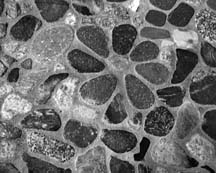 The ensuite bathrooms with Desert Sand slate crawling up the walls and flat stones collected from the beach covering the shower floors are like a mini-spa retreat and great for washing off the ocean salt spray from a long day of water sports.
The ensuite bathrooms with Desert Sand slate crawling up the walls and flat stones collected from the beach covering the shower floors are like a mini-spa retreat and great for washing off the ocean salt spray from a long day of water sports.
This creative formation of stones in the ensuite shower floors makes it fun to try and spot the art.
Profile of a Chief
Meet Tla‘amin Chief Clint Williams
Last fall, Sliammon First Nation elected a new chief and council. Many Powell River residents are not familiar with Chief Clint Williams so Powell River Living wanted to introduce him to the community.
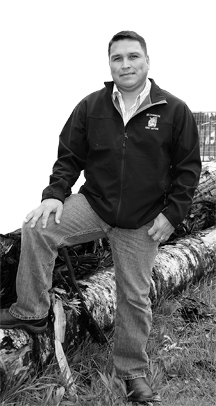 First and foremost, Sliammon Chief Clint Williams wants to unite the community of Sliammon First Nation. He knows that communicating clearly and effectively is important; he also knows that listening to other perspectives is necessary.
First and foremost, Sliammon Chief Clint Williams wants to unite the community of Sliammon First Nation. He knows that communicating clearly and effectively is important; he also knows that listening to other perspectives is necessary.
“There’s a division in our community between some people,” Williams explained. “I’m hoping I can communicate with all these different groups and factions and get everyone working together.”
Williams was elected as Chief of Sliammon First Nation in September 2008 but he is no stranger to politics—he was first elected to band council in 2000. Williams grew up in Sliammon; he and his wife Angelina have two sons, Colton, 16, and Kyler, 13.
“When I was 20 I began working with the Ministry of Forests,” he said. In his work as a Forest Fire Prevention Technician Williams had the opportunity to see and learn a lot. “I bounced around a bit in the ministry doing some site inspections and during down time I worked with compliance and enforcement staff, the timber block layout section and log scaling staff. This was a very good learning opportunity and I received lots of training.”
He fought fires in Ontario, Alberta and Saskatchewan and all over BC. “I got to meet a lot of interesting people.
At the same time, Williams sat on the Sliammon Treaty Society board (five years) and then in 2000 he was elected to band council. In 2002, he left the Ministry of Forests and chose not to run in the next election.
Williams was hired by the Treaty Society as a land use planning technician in 2002 which he did until 2007. In 2004 he was elected to band council for two terms and in 2008 he was elected as Chief.
Williams and a committee from council created Tla’Amin Timber Products Ltd. in 2007 and today, Williams works for that company as Forestry manager.
Although people differ in their political views, Williams says they share the same overall vision and concerns and want what is best for Sliammon.
There have been challenges and Williams knows there is no quick fix. One immediate issue that needs to be dealt with is the drug problem on the reserve. On January 24, 2008, the drug referendum question “Do you agree that the Sliammon First Nation should banish drug dealers from Reserve Lands?” was asked. 150 out of 172 said yes. Since then, Sliammon has drafted a banishment law and a community protection law that required further consultation and so the Community Day of Action was held last month to create an action plan to determine the next steps.
“Some dealers have recruited kids that are 13 and 14 to basically be their sales people,” said Williams. The drug issue isn’t unique to Sliammon, however, because Sliammon is a small and tight knit community everyone knows everything sooner, Williams says. “You know the names of all the people here and it really hits home.”
“This is a community issue. There are people who do not feel comfortable taking an evening walk. The people of Sliammon have been writing letters saying you need to do something,” said Williams.
“I don’t want to see our youth robbed of their childhood. I have teenage boys and I think, ‘What would I do if this was happening to us?’” said Williams.
By standing strong, by standing united, Williams believes that Sliammon First Nation can overcome any challenges that may show up today and in the future.
Amish Gah
Let’s go! fitness program
Sliammon First Nation has a new exercise group called “Amish Gah” which means Let’s Go. It started in April and already some 30 to 35 people get together and walk, jog or run a one-to-two-mile route on a regular basis.
 Cyndi Pallen, Tla’Amin Health Services worker, says the program was made possible because of a grant from BC Recreation & Parks.
Cyndi Pallen, Tla’Amin Health Services worker, says the program was made possible because of a grant from BC Recreation & Parks.
“Along with the walk, jog, or run, we thought it would be fun to incorporate a cultural emphasis and used the eagle as a metaphor. All participants are encouraged to dance like an eagle at the finish line and these individuals have their name entered for an Eagle draw for Eagle prints.
“As a frontline worker in a small community we have worked to be creative in implementing healthy activities with a cultural component.”
On June 21, Aboriginal Day, they will be walking from Sliammon Health Services to the Patricia Theatre for a screening of the “Tribal Journeys” film from last year’s massive canoe event. Funds raised from the event will go to helping send two canoes from Sliammon to this year’s event.
Everyone is welcome for bannock, singing and the film.
Time to plant
Sow a little but sow more often
By Jonathan Van Wiltenburg
Everything is in neat rows, new leaves are showing their faces, and the sun is out long and strong. This is the month that begins to reveal the ability plants have to capture the sun’s energy and convert it into bounty. As the risk of frost has now passed, over next few months we can shift our focus from planting to include maintenance.
Even though we are cruising into full bloom summer, you must still keep seeding to keep the fresh food regular. Live by the rule of “sow a little more often.” Some vegetables tend to bolt (go to flower) so sowing every two weeks should be about right to maintain a continuous supply. To name a few, sow more lettuce, greens, Asian greens, cilantro, carrots, beets, peas, beans, and dill. With improvement in the weather it also is imperative to maintain proper greenhouse temperature.
Make sure the ventilation is properly adjusted. White wash the windows if you can’t keep the temperature below 35°C. Remember to fertilize your container plantings; if you have soil that is less than par give all the plants a good feeding. I recommend a good organic fertilizer.
As was mentioned, maintenance is our new thing. The best thing we can do in June is to stay ahead of the weeds. Plants are most affected by competition when they are young so the earlier you can eliminate the weeds the better. Take time (it should not take too long, don’t be too fussy) to hoe your entire garden even before you see them arrive. The idea is to disturb the weeds before they have time to anchor and grow. While you’re at it, thin out the seedlings that are growing too close together. Try weeding on a hot dry day so the traumatized young weeds will dry out and die (carrots are the exception). If you do this once a week for the next 4-5 weeks, by later summer weeds will be the last thing on your mind.
The vegetables should be growing nicely by now. As June progresses harvest as much as you can. Keep harvesting the asparagus and rhubarb until mid to late June. Harvest lettuce, peas, fava beans, early potatoes, young carrots, and radishes. Try not to let vegetables get too mature. Generally younger is tastier in the vegetable world. Take note as to the arrival of pests and disease. Use appropriate action (organic method of course) if the populations get out of control. Some signs are holes in leaves, curling leaves, wilting plants while soil is still damp, webs, sticky residues, black spots etc.  The tomatoes plants, (and perennials, especially delphiniums) should be supported. Also as you tie up your tomatoes pinch off the side shoots that are growing in the crotches of the side branches and main stem (see picture). This will focus the growth of the vine and maximize quality fruit production. In the potato patch hill up the plants (cover with soil) as they grow. Keep this up and the potatoes will be plenty. Your fruit should also be well on its way. Gooseberries should be ready to eat if you have them. The strawberry harvest is around the corner so keep an eye on the slug situation in the strawberry patch. Go out at night and pick out the slimy miners if necessary. Watch for birds. Put out netting or flashy things on strings if need be. Also you can now begin to thin fruit on your trees. This will ensure larger healthier fruit set and also will diminish the amount of fruit that drops prematurely later on in the season. Aim to have about a fruit every 10 cm for larger fruit. Watch for pests on new leaves. If aphids are the culprits wash them off with a strong stream of water before the colony gets too large.
The tomatoes plants, (and perennials, especially delphiniums) should be supported. Also as you tie up your tomatoes pinch off the side shoots that are growing in the crotches of the side branches and main stem (see picture). This will focus the growth of the vine and maximize quality fruit production. In the potato patch hill up the plants (cover with soil) as they grow. Keep this up and the potatoes will be plenty. Your fruit should also be well on its way. Gooseberries should be ready to eat if you have them. The strawberry harvest is around the corner so keep an eye on the slug situation in the strawberry patch. Go out at night and pick out the slimy miners if necessary. Watch for birds. Put out netting or flashy things on strings if need be. Also you can now begin to thin fruit on your trees. This will ensure larger healthier fruit set and also will diminish the amount of fruit that drops prematurely later on in the season. Aim to have about a fruit every 10 cm for larger fruit. Watch for pests on new leaves. If aphids are the culprits wash them off with a strong stream of water before the colony gets too large.
Most of all, enjoy yourself out there. The sun is finally out and you’re eating you own food!
Nettles
Amazing plant is worth the sting
By David Parkinson
On a chilly and grey morning in mid-April, we met at the ballpark in Gillies Bay before setting off on an expedition. Our purpose? To stalk the wild stinging nettle (Urtica dioica). Our guide? Local herbalist and wild plant expert Doreen Bonin, who has been wildcrafting and making herbal remedies for 15 years.
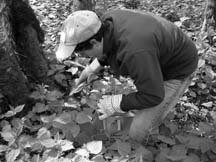 Doreen is eager to share what she has learned over these years of study and practice. As she says, “One of my greatest rewards comes from celebrating the many benefits of wild plants with others who are eager to empower themselves through plant wisdom. I believe that when we slow down and align with the plants, we open ourselves to healing, and gratitude for the sacred abundance of Mother Earth.”
Doreen is eager to share what she has learned over these years of study and practice. As she says, “One of my greatest rewards comes from celebrating the many benefits of wild plants with others who are eager to empower themselves through plant wisdom. I believe that when we slow down and align with the plants, we open ourselves to healing, and gratitude for the sacred abundance of Mother Earth.”
From the ballpark we proceeded to the Texada airport and walked for about a half-hour, stopping along the way to observe some other medicinal plants of interest: mullein, St John’s wort, devil’s club, and numerous others growing alongside the path. Doreen’s enthusiasm for these plants was infectious, and she answered all kinds of questions about their uses, how to gather and store them, and the times of year they are best gathered.
At the end of our walk, we came upon a grove of trees with dappled sunlight shining down through the branches. And on the ground, almost as far as the eye could see, nothing but stinging nettles. For anyone who has ever been stung by nettles, this is a fairly daunting sight; but luckily we had come prepared with long pants and gloves. After some pointers on how to gather the best nettles (midday is the best picking time, as the leaves will be dry; only take the top few leaves; avoid bug-eaten leaves; don’t pick the tops which are beginning to flower), we got to work.
After an hour or so of wandering around that grove, snipping off the tops of nettle plants, breathing in the calm and quiet atmosphere of a beautiful and healthy little ecosystem, we gathered on the beach and talked about this miraculous plant. Here’s some of what Doreen had to say about the incredible properties of the stinging nettle:
“There is no denser nutrition found in any plant, gentle enough for an everyday nourishing brew and powerful enough to heal damaged tissue. Kidneys, lungs, intestines, and arteries are tonified, strengthened, and gradually altered toward optimum functioning with consistent use of nettle.”
She spoke of the benefits of preparing an infusion of nettle leaves, by pouring boiling water over dried nettle leaves and allowing it to steep for four hours. This infusion is a rich source of vitamins, minerals, and protein. Nettles, like many plants with medicinal qualities, can also be used to make an alcohol-based tincture, or an oil or vinegar infusion.
The sting which gives the nettle its name and bad reputation comes from thousands of tiny spikes on the undersides of the leaves and along the stem. When we touch these spikes, their tips break off and inject a mixture of irritating chemicals into our skin. As anyone knows who has been badly stung by nettles, this stinging or burning sensation can last a couple of days. The lucky thing is that apart from some discomfort it causes no bad effects, and is even considered to be a remedy for rheumatism and arthritis.
Another way of using nettles, which many people in this region are familiar with, is to steam or boil them and use them as one would use any other leafy green vegetable like spinach or kale. The cooked greens can be blended with stock and seasonings to make an astonishingly tasty soup, or used in Spanokopita or lasagna. If you’re ambitious enough to gather large amounts, you can freeze the cooked leaves and pull them out for any recipe calling for greens.
All in all, an amazing plant!
Doreen is planning to organize more plant walks throughout the spring and summer. If you are interested in participating, contact her at dbonin8@telus.net.
Pardon My Pen
By George Campbell
The rustler of Haida Gwaii
This here is the true story of Al (Bad Boy) Brown, the only logger in the history of British Columbia to be arrested and brought to trial for rustling cattle on the Queen Charlotte Islands.
Today Mr. Brown is a respectable, retired, resident of Powell River, but at the time this story took place he was living with his wife and daughter in Port Clements on Masset Inlet on Graham Island in the Queen Charlotte’s. He was logging for the MacMillan Bloedel company. The wages were good, the job was steady, and the people were friendly. There are five small towns on this island, and each one is less than 60 kilometres from the next. It is the kind of place where everybody knows everybody else.
One thing that everybody up there knew was that there was a small herd of cattle on the island that had gone wild. They were the remnants of an unsuccessful attempt at ranching that had taken place many years before. Nobody knew for sure just how many cattle were in this herd, but just about everyone up there had shot one at some time or another.
This beef was claimed to be extremely flavourful and tender. “The best meat you ever tasted,” according to some. In the fall of 1981, logger Al Brown shot one of these beasts. He skinned it, cut it up, and put it in his freezer. He agreed with his neighbours. It was the finest beef he had ever eaten.
In the third week of January 1982, RCMP Sergeant Myles Hanke, knocked on Al’s front door. He wasn’t there to sell Al a ticket to the policeman’s annual ball. It seems that someone had claimed ownership of the cow Al had shot, and had issued a formal complaint for his arrest. Al admitted to the officer that he had indeed shot a cow, but proclaimed innocence of any wrongdoing on the grounds that he thought the cattle was wild and that no one really owned them. Hanke explained that was up to a judge to decide. Al found himself charged with rustling cattle and had to appear in court.
The first thing the rustler did was hire a lawyer. And he knew just the one he wanted. It was a friend of his who had just happened to shoot a cow out of the same wild herd about a week before Al had shot his. Al said to his lawyer friend, “You’d better get me off, pal, because if I’m goin’ down, so are you!”
Al and his lawyer ended up appearing in court five different times. The case became more complicated as time progressed. The person who originally issued the complaint was unable to prove ownership of the cow Al had shot, but the law held that he was still guilty of wilful destruction of property. Finally, on June 28th, 1982, the judge brought down his verdict. “Guilty of rustling cattle under section 400(a) of the Canada Criminal Code.” But because the cattle was unowned, and due to the circumstances involved, there would be no sentence handed down, and rustler Al Brown would have no criminal record attached to his name.
Al was happy to be off the hook; his lawyer was happy because he got paid; and the law was happy because they settled the case. The only one in the whole affair not happy was the cow Al shot.
Thus ends the saga of Al (Bad Boy) Brown, the only logger in the history of British Columbia to be charged and convicted of rustling cattle on the Queen Charlotte Islands. It’s a matter of record. You could look it up.
Powell River Pugilism
Boxing Club wants to expand
By Gerry Gray
The “gym” in which I met Les Vegas and Doug Martin was a far cry from New York’s’ famous Stillmen’s Training Centre, but then what can you expect from a refurbished basement? The ceiling was low, lights marginal, and space limited. At the back of the room, a ring was set up and three punching bags hung from the ceiling.
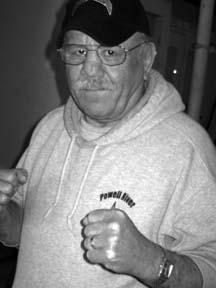 Vegas, promoter and trainer of the Powell River Boxing Club, noticed my scepticism. “It’s a start,” he said. “We’ve been looking for new premises but haven’t had much success, as you can see.” I asked Martin, a former newspaperman, what his job was. “I guess I’m just general factotum and offer help when it’s needed. Les does a great job with the kids and I fill in sometimes.”
Vegas, promoter and trainer of the Powell River Boxing Club, noticed my scepticism. “It’s a start,” he said. “We’ve been looking for new premises but haven’t had much success, as you can see.” I asked Martin, a former newspaperman, what his job was. “I guess I’m just general factotum and offer help when it’s needed. Les does a great job with the kids and I fill in sometimes.”
The club has been training kids and adults, male and female, for the past four years. First at Malaspina College, then the old Safeway and, with a few stops in between, the Boy Scout basement.
The night I went down for the story, it was a hive of activity. Two teenaged girls were in the ring (no contact), all three punching bags were being used and a couple of youngsters were sparring in the corner.
I talked to Vegas about the highs and lows of starting such a sport in this city. The following is our Q/A dialogue:
Q • What motivates you to start a club like this when there are so many other sports for youth in Powell River?
Les: I’ve been a boxer for many years and I know how the training and competition can do so much for youth, and even older adults.
Q • You say you’ve been open for business for the past four years. How many active members do you have?
Les: About 20 boys and girls come down here (the basement of the Scout Hall) to work out on a weekly or monthly basis.
Q • I notice your premises are slightly cramped for a boxing venue. Have you any plans to move to a larger space?
Les: We have been trying to find a better place for a couple of years. The present area is okay but there is no room for skipping or even for parents who want to watch their children work out.
Q • Anything in the offing that looks good?
Les: We’re working on a school gym but that’s a while in the future. Councillor Dave Formosa offered use of his building at Duncan and Joyce but only for three months. That was too short a time for us to move our equipment and then bring it back in 90 days.
Q • Speaking of equipment, you have a nicely set up ring, three punching bags and a wicker love seat. Were these items donated?
Les: Yes. People have been more than generous. Bill Morton, owner of Garnet Rock Appliance and Vacuums, proprietors of the building, told us if we clean up the area we can use it. Other people have donated money for us to buy gloves and workout gear, etc.
Q • How much does membership to your club cost?
Les: Nothing. Nobody who works out here pays a nickel.
Q • Do you do all this by yourself?
Les: Yes, and our wives think we are spending too much time and money on the club. But it’s not serious.
Q • How do you answer the criticism that boxing is a contact sport and people can get hurt in the ring?
Les: We take all precautions. Gloves are well padded, no one gets in the ring without me or Doug refereeing and we keep weights as equal as possible. However, no matter what sport you are involved in there is always the chance of injury.
Q • You mentioned a couple of your members won medals. Was that in cards outside of Powell River?
Les: We can’t put a show on here so we have to travel and it costs money. Somehow we have to pay for trips out of our own pockets and that hurts.
Q • Now the big question. How did you come by the name “Les Vegas” or is your real name?
Les: I knew you would ask. My real name is Lazlo Vajai, which is a killer for the media to pronounce. So I complained to my trainer and he said let’s cut it down to Les Vegas. I said okay and it stuck.
Q • You look like you’ve been in the ring for a few rounds, what’s your boxing experience?
Les: I was in the game for about 20 years. The highlight of my career was when I won the welterweight championship of BC. I’ve fought in Victoria, Vancouver and a lot of other places, mostly in this province. It’s good to keep in shape.
Q • Any other comments?
Les: What is needed desperately is a place with more space and hopefully showers so we can expand and have room for shows and the public can be further involved.
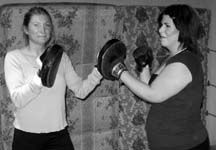
Powell River’s fighting history
Boxing has had its good times and hard times in Powell River and perhaps the Golden Years were the late 1920s and through the Dirty 30s.
Three Bobs: Dunn, Redhead and Turnball, dominated the ring in those early years. Jack and Bill Sweeny were also title contenders and Bill, weighing in as a welterweight at 147 pounds held the BC title for a year. He was considered one of the toughest pugilists in the country in his prime.
Bob Dunn was a leading lightweight, beating Doug Powell of Vancouver to cop the Golden Gloves championship, a much coveted title. Art Betteridge held the Lower Mainland championship in 1938 after defeating the popular (and tough) Kenny Lindsay in one of the most spectacular bouts that season.
In 1937 Mickey MacPherson was BC middleweight champ and heavyweight Stew Lambert along with Johnny Applegate, a featherweight, were prominent in the provincial rings.
Wrestling was a big draw in those days and a Powell Riverite, Alt Anderson won the Canadian middleweight championship in 1938. Wrestlers of note were Jack Gebbie, Arnold Kauffman, Jack Hanna and Irish Shannon along with Baldy Haddock and Floyd Enos made up most of the fight cards on Saturday nights. In 1948 Ray Rees was named Best First Year Entry in the Vancouver Golden Gloves contest and was one of the last local boxers to capture a provincial tile as the fans turned away from the sport and soccer, baseball and lacrosse dominated the sporting scene.
Boxing made a slight comeback in the early ‘70s when Gerry Burton started up a club which lasted a couple of years until it too closed because of lack of attendance. However it’s a sure bet that the present Boxing Club will succeed if proper accommodation can be acquired to set up a decent training gym.
International boxing was at its height in popularity in those “good ol’ daze.” Joe Louis (The Brown Bomber) was the top name in sports. When he fought every radio on the block was tuned in and when he demolished Max Schmelling in the first round the country went wild. “Take that Mr. Hitler!” was the cry. Schmelling was a heavyweight from Berlin, Adolph Hitler was a lightweight from Austria. The names of some of those great boxers still come to the minds of anyone who lived in that era. Max Baer, Jesse Willard, Gene (Long Count) Tunney, Tommy Farr, Two-Ton Tony Galento, (who trained on beer) and many other aspiring punching bags.
Wrestling had a revival in Powell River during the ‘70s when tag teams on tour would arrive for Saturday night bouts in the old Arena. Sometime, if the card was good, more than 1,000 fans packed to stands to cheer on their champions. It was a good night for all and when the building was condemned by the fire and electrical commissions there was a great sense of loss in the community.
Business Connections
By Kim Miller
Summer is finally here and the business community is hanging out beautiful flowering baskets and sweeping the sidewalks. Colourful signs are popping up in windows inviting customers to come inside and see what’s new.
The Chamber and the City’s Parks and Recreation department recently held a community open house at the complex regarding “beautification.” Powell Riverites are very interested in participating in the provincial “Communities in Bloom” program. A committee will look at specific areas to clean up, enhance and beautify. We encourage everyone to spruce up their own residences and business storefronts. Check www.prbeautification.com for updates.
Stitch Sewing Company at 4690 Marine Ave is operated by Miwa Hancock. She says “we basically do everything regarding sewing and alterations.” Mia and her family have lived in Powell River just about a year now and love it here. You can call them at 604 485-5579, or just stop in and say hello.
Studio 101 Hair & Body Bar at 105, 4675 Marine Ave is owned and operated by Karen Staniforth. Karen recently relocated from Fort St James to Texada Island where she has family roots. She hired three staff who offer services for hair, nails and aesthetics. Call 604 485-5600 for an appointment.
CMG Printing will open in mid-July in the space formerly occupied by Big Robbie’s on Marine Ave. Corey Matsumoto (editor of Immanence Magazine) is offering a wide range of printing services from business cards to brochures to short-run books. He’s adding some binding equipment to be able to do perfect binding for books. He’ll also have a small retail operation offering eco-stationery. Printing will be done on 100% recycled paper as a standard, says Corey. Call him at 604 489-0133.
Yellow Rose Chauffeur starts serving Powell River on July 1. It’s a transportation service for seniors, with one-on-one companion for shopping, doctors visits and such. There is a base fee plus a per kilometre charge, both very affordable. Owner Sonia Southern will stay with clients to run their errands with them. She is also offering the service for out-of-town appointments. Call Sonia at 604 223-1150
Paige Nahornoff has opened Top Dog Walks. She offers dog walking and pet care services including feeding and special care when needed. Depending on availability, she will offer overnight pet-sitting in the client’s home. Paige ran her own business in Vancouver until relocating to Powell River (where her husband grew up) in fall 2008. She has cared for every size of dog, from miniature Yorkies to Great Danes and Bull Mastiffs… and everything in between. She can also deal with oral medications, special diets and mobility concerns for elderly animals. Paige offers pick-up, and drop-off for smaller dogs and for cats. For more information call 604 414-4038, or email her at pnahornoff@live.ca
A big push is on to encourage everyone to use the online Community Calendar. Produced and maintained by Norah LeClare and financially supported by the Chamber, PR Economic Development Society, Arts Council and Tourism Powell River, this calendar is a great tool for everyone planning a community event or wanting to attend one. Do you know when big events like Sea Fair, Blackberry Street Party, Texada Sandcastle weekend, or any of the other events? You will when you use this terrific online tool. Check it out at www.powellriverdirect.com.
Congratulations go to Dawn Adaszynski for her recent appointment as managing broker for Coast Realty Group. Dawn has been with the company for 22 years, first with Vogl Agencies and now with Coast Realty Group Powell River Ltd. Dawn assumes this new role with the retirement of Joe Mastrodonato.
Do you have changes at your business you would like Powell River to know about: a new manager or owner, or how about major changes or a move to a new location? Starting a new business? Tell us about it by calling 604 485-4051.
 Family Matters
Family Matters
By Isabelle Southcott
Helping each other
You can’t help but feel the power of people. When I think of Powell River, I think first of its people, for it is our people who make this community so very special.
At one stage I thought I needed to live a balanced life. I thought that a working mom needed to balance her family, social, spiritual and leisure time. And so, I tried to live in balance. Trouble is, with balance, you must constantly add something or take something away in order to achieve balance.
I finally figured out the life I wanted to live wasn’t about achieving balance but about integration. When you integrate everything that is important to you, you will live in harmony. If you are true to your values and beliefs in all you do, your life will become more meaningful and the people you work with and spend time with will be in harmony with you and your values.
I have the good fortune to work with some great people. Yes, we are different in many ways but where it really counts, we are in harmony. Powell River Living magazine is a home-based business; some people who work in the business also work in my home. We genuinely care about each other and understand that work and family overlap. Family comes first because in the end, will you be lying on your death bed wishing that you had spent more hours at work or more time with those you love?
A couple of weeks ago I attended a conference. Bonnie, who runs the office here, (also known as the Queen of Everything) volunteered to look after my children. Now this is way beyond what I would expect anyone who works for me to do. But Bonnie, being Bonnie, was adamant and so I gratefully accepted her kind offer. Not only did Bonnie look after my children but she took them to the Bruce Denniston Bone Marrow Cookbook launch and on Saturday night had three extra children over for a sleepover! Now that’s what I call going above and beyond the call of duty.
Why did Bonnie do this for me? It wasn’t for money. It was because she cares about me and because she supports the magazine and me and is the kind of person who always asks: “How can I help?”
The reason why everything works so beautifully is because we are so connected with each other and we do what we can to help each other succeed. We communicate with each other, ask questions and genuinely care about people.
Powell River Living isn’t a slick, glossy magazine. It’s a community magazine that cares about people. It’s a community effort in every single way, from the stories written by our contributors to our advertisers and to people like Bonnie who know it takes a community to raise a child.
Point of VIU
He was a King, and he’s a prince of a guy: Meet Clay Harvey
By Dawn McLean
 Clay Harvey first came to Powell River three years ago from Gull Lake, Saskatchewan. A former coach talked him into coming out to the coast to try out for the Kings’ Junior A hockey team. “It was the first time I had ever been on a ferry. I had never seen the ocean before,” Clay recalls.
Clay Harvey first came to Powell River three years ago from Gull Lake, Saskatchewan. A former coach talked him into coming out to the coast to try out for the Kings’ Junior A hockey team. “It was the first time I had ever been on a ferry. I had never seen the ocean before,” Clay recalls.
After staying a few nights in a hotel, he met his billets, Dave and Sonia Csuk, and lived with them for three years. From the very first day, Clay fit in. With his laid-back personality and willingness to work hard, he was more than a hockey player who needed a place to stay. “We’ve seen him grow up a lot over three years. He became a huge part of our family. He brought wonderful values and was a big brother to our kids,” says Sonia. “We’ve become friends with his family, too, and they would stay with us when visiting Clay.”
Sonia reflects this year was Clay’s most demanding, working on his game and going to school full time—but he never complained. “We are all going to miss him more than I can say.”
Clay says he was fortunate to have the Csuks as billets. “They pretty much let me just play hockey. I was absolutely spoiled. They acted like both parents and friends. I liked to follow my routine for eating and sleeping on game day. They let me have my freedom, but they looked out for me. I will miss them when I have to fend for myself in college.”
Work is something Clay is used to, but it took time and effort from Clay and all the Kings since his arrival in 2006 to put together a winning team. “When I first got here, we absolutely sucked. We won three out of twenty games, maybe. We had a couple of coaching changes and then Kent (Lewis) turned the whole program around.”
Coach Kent Lewis says he’s worked hard to find the right players for his team. “Clay is a great guy in the room—he’s a key character, one of three or four leaders. He’s very well rounded in what he was able to bring to the team. Kent says they are proud of Clay and were particularly pleased when he earned the award for academic player of the year. “He’s a great guy—liked by everyone. He’ll do well.”
This last year with the Kings was Clay’s finest year ever. “We won our coast conference. All my teammates went to bat for each other—we accomplished a lot.”
Clay is humble in stating his accomplishments. He not only was a part of the team that won the regionals, but also he was scouted and earned a scholarship to Quinnipiac University in Connecticut. “I had the opportunity to go there last year, but I wasn’t ready for their academics. I was happy to stay in Powell River because our team was going to be good. I knew I needed to prep for a bigger school.”
Hearing from other players who had taken courses at Vancouver Island University’s Powell River campus, Clay decided to enroll. “I learned how to write a paper, and I am starting to learn how to study better. All the stuff I wasn’t interested in learning, I am starting to learn now. For example, I really loved my history class. Dr. Thoms made it come alive—it wasn’t like reading stuff out of a textbook.”
Having instructors who understood that Clay was a busy and committed player helped. They worked with both Clay and Coach Lewis to come up with a schedule to accommodate Clay’s commitments. Clay is quick to give praise: “Everyone was great. Classmates were helpful, too. They shared notes, kept me informed and up to date. But if I didn’t go to the writing centre, I am not sure if I would have passed. I would have packed it in. Sandy Elvy, the university coordinator, gave me a hug when I needed one—they all understood what was at stake. The advisors helped me figure out what I was getting into next year. Hockey players will find that if they go to VIU, they’ll get them through.”
It also helped that Clay has a supportive family in Saskatchewan. They encouraged him to keep focused even though they missed having him home, Clay says it was hardest on his mother. “She was pretty sad that I was moving so far away. They knew Clay wouldn’t always be able to lend a hand on the family farm—32-quarter sections. They visited as often as possible and were always able to see their son play on the league website.
 It took a village to get Clay to where he is headed—Clay is appreciative of his fan base. He comments how the fans got the “hockey buzz” again. “It was pretty cool. When we came home from winning in Victoria, fans were waiting at the ferry. And even after our loss (against Vernon) they still greeted us and seemed to be proud. That felt pretty good.” He speaks proudly that he has a number one fan, a little girl who proudly wears his name and number on a pint-sized Kings jersey. “I loved the street hockey games. It’s great to hang out with the kids, tease them, and encourage them at community skates.
It took a village to get Clay to where he is headed—Clay is appreciative of his fan base. He comments how the fans got the “hockey buzz” again. “It was pretty cool. When we came home from winning in Victoria, fans were waiting at the ferry. And even after our loss (against Vernon) they still greeted us and seemed to be proud. That felt pretty good.” He speaks proudly that he has a number one fan, a little girl who proudly wears his name and number on a pint-sized Kings jersey. “I loved the street hockey games. It’s great to hang out with the kids, tease them, and encourage them at community skates.
Clay has mixed feelings about leaving Powell River and the Kings hockey team. “That last game, I looked around the room to see the others who were done—how important it was to my teammates, what we meant to each other, what we’ve been through. It’s hard to know I won’t be coming back next year. I need to get my head around that it’s been a stepping stone to something else.”
Clay Harvey fans can follow his games for the Quinnipiac Bobcats at their university website: www.quinnipiacbobcats.com.
For Art's Sake
By Jessica Colasanto
Poet and painter combine works for exhibition
…and I can still remember,
even if she doesn’t,
how we set out one morning
earnest and early…From Moon by Allan Brown
Artists work hard at their craft. Musicians practice, painters draw studies, performers rehearse, writers churn out daily exercises—so that when inspiration hits, they’re ready. Inspiration can often be found in the usual haunts, but many times it comes by complete surprise.
Such was the case when a casual conversation brought poet Allan Brown and visual artist Johann Wieghardt together. The idea of doing a show together took both by surprise, and the result, ArT TalK, promises to be a rewarding experience for us all.
Allen Brown recently published a collection of selected poems, Frames of Silence. Wieghardt has reacted to five of those poems by producing brand new sculptures and paintings. And Brown will present a set of new and original poems, extrapolating ideas from the images found in several of Wieghardt’s paintings.
An artistic talk opens the exhibition on Friday, June 19th, in room 152 at Vancouver Island University on Selkirk Street, beginning at 6 pm. Brown and Wieghardt will host a stimulating discussion about the challenges and rewards of reflecting upon each other’s work. They’ll also share anecdotes of inspiration and surprise.
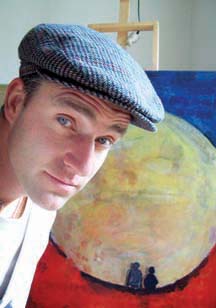 Brown’s Moon is one of the poems Wieghardt chose to reflect in a painting. The poem itself moves from verse to prose, exchanging ideas and form, perhaps symbolic of the entire show. How forms interrelate, how they can complement one another or create friction, how one reflects the complexity of the other; these ideas will be evident.
Brown’s Moon is one of the poems Wieghardt chose to reflect in a painting. The poem itself moves from verse to prose, exchanging ideas and form, perhaps symbolic of the entire show. How forms interrelate, how they can complement one another or create friction, how one reflects the complexity of the other; these ideas will be evident.
Along with new works created specifically as a reaction to the other artist, the show will include existing pieces that have approached art in the same way, such as paintings reflecting the imagery of Holbein and poems inspired by Leonardo and Matisse. Both artists have produced work directly influenced by Rembrandt.
The exchange of ideas in ArT TalK promises to enhance our own reaction to each piece. It’s not unusual for artists to be influenced by their predecessors and peers; this is how groups and schools are formed. But to see a work as interpreted by another artist is a rare treat, particularly when the ultimate goal is to stimulate discussion.
ArT TalK will remain on display in room 152 at VIU through July 24th. Both Wieghardt and Brown are members of the Malaspina Art Society (www.ArtPowellRiver.ca.)
Another event of note is Some Amount of Dreaming. Hosted by MAS, this exhibition of works by Adrienne Robillard and Aaramë Robillard will be on display throughout June in the Malaspina Exhibition Centre (the public gallery in the VIU lobby.) Although each has a distinct style, both mother and daughter have been working with Khadi paper, a hand-made product from India formed sheet by sheet. It lends itself well to watercolour and printmaking, and an interesting selection of their creations will be on display.
Whether in room 152 or the lobby, VIU houses some great work this month. Be sure to stop in and enjoy the experience as you show your support of our vibrant arts community.
What is it with the weather?
Blame it on CO2
By Elizabeth Milward
Last winter was unusually cold. This may seem to contradict the idea that climate change is occurring, but that isn’t so. In order to understand what is actually going on, a more in-depth look is required.
A La Niña event occurred this past winter. La Niña results in cooler water temperatures in the equatorial Pacific, as well as in many other effects around the globe. The La Niña included a cold mass of water off the coast of North America which resulted in cold weather and large dumps of snow. This La Niña is now considered to have finished and conditions are now normal or near-normal which means our summer weather will be more what one expects from Powell River.

La Niña’s opposite is El Niño and they are together referred as the ENSO, or El Niño/Southern Oscillation. This cycle is irregular, but is usually 3-5 years in length. El Niño is more famous than La Niña, and many of the record hot weather events of recent years have occurred during El Niño’s. Climate change is predicted to increase the strength of the El Niño at the expense of La Niña, but La Niña’s do still occur, as we saw this last winter. For more information visit www.cpc.noaa.gov.
The scientific basis for climate change is that there is an increasing amount of Carbon Dioxide (CO2) in the atmosphere. CO2 acts as a greenhouse gas and when records of past temperature and CO2 concentration in the atmosphere are examined, the two move in tandem. CO2 goes up, global average temperature goes up; CO2 goes down, the global average temperature goes down. On a graph, the relationship is unmistakable.
The first half of this graph shows the average global temperature and CO2 over a period of hundreds of thousands of years. Temperature is top and CO2 is bottom. Over short periods of time such as a month, a year, or even ten years, the linkage should be much less noticeable because it is masked by complicating factors such as the ENSO.
One other thing to keep in mind is that climate change is also predicted to result in an increase in the number of extreme weather events and general climatic unpredictability. While most of the extreme weather events are likely to involve hot weather rather than cold, the increase in unpredictability means that there will be some strong cold weather events at unexpected times when they are extremely awkward. Unfortunately, they do not mean climate change is not occurring.
So just because Cranberry Lake froze over so thoroughly that someone drove a vehicle onto the ice and the spring flowers were all late doesn’t mean that climate change has somehow stopped happening. Short-term climate cycles may mask what is going on, but it is occurring nevertheless.
Planning to sell your house?
Make it look good
By Terri Glen
If you’re going into a playoff game, you need time to prepare yourself and get our game plan on. That’s true when selling your home, too. Local home stager Terri Glen has put together a check list to get you thinking about what needs to be done before selling your home.
- Have your house appraised by the realtor and find out where you are in the market.
- Go through the house room by room making a list of replace, repair, and repaint jobs.
- De-clutter and remove unused articles, objects, and collectibles.
- Call a stager to help with the vision a buyer is looking for.
- Recreate the home let go of old memories.
- Book your painter, plumber, carpenter and electrician.
- Add space, lighting and cleanliness to maximize the available space.
- Your stager will employ strategies to create the illusion of more space with style to help sell at the price you want.
- You want photos on the internet that represent good first impressions.
- Curb appeal is next. Get started early.
Flying and Fly-ins
Not just for pilots
By O.C. “Doby” Dobrostanski
I have noticed that many people are deeply enamoured by the idea of flight. The serious comrades in this passion are widely varied in their tastes and involvements with flight. Some are mechanics who have wonderful skills and knowledge so specialized that their very signature on a sheet of paper declares an aircraft safe to fly thousands of kilometres carrying hundreds of passengers. In fact, without that signature, no commercial or military aircraft can legally leave the ground. Others are commercial or military pilots with thousands of hours at the pointy end of aircraft, a dozen miles above the earth, in -50o degree temperatures, some hurtling along at speeds beyond sound. Still others fly slowly and low, in commercially built and proven airplanes with familiar names like “Piper”, “Cessna”, and “Beechcraft”. Others, and recently more than ever, in home-built craft that vary in shape, size and configuration. Some aircraft are old, some new examples. There are even extremely valued old ex-military aircraft being refurbished and flown on a daily basis.

But all of these, including the Sunday afternoon club flyers in canvas and wood frame antiques or ultralight planes that barely fly along at the speed of a slow car on a country road, have something in common. Flight is the ultimate involvement. The glider pilot, with no engine, the balloonist in a wind-directed envelope of warmed air and the paraglider pilot all share the same passion with jet pilots and astronauts. They do not belong to the gravity-challenged. “Flight” as an ideal state is the prolonged and consistent drive among these people. A more removed group within this hugely popular area of interest are simply those who love airplanes, flight, and aviation in general.
I have seen aficionados sit in their automobiles and watch airliners taking off and landing for hours at the end of the long twin runways at Vancouver International, on the service road beside Edmonton Municipal Airport and in Los Angeles at LAX. This interest is not an isolated phenomena.
Flyers love to get together and talk flying, airplanes, mechanicals, navigation, weather, training, instruments and on and on… with other pilots, aviation mechanics and those who are involved in flight. The subjects of conversations of flight aficionados are not likely to be conservative. If one was to listen in, one would hear of superlatives, both mechanical and social, applied to the people who fly and their machines.
That is the essence of a “fly-in”. It is a gathering of pilots, their airplanes and fellow passionate aviation buffs. Some fly-in locations provide camping facilities for the pilots and their crews, and they just park the aircraft, pitch a tent under the wing and just relax. Throw in a breakfast, a barbecue and maybe an evening of sitting around a campfire or at a cozy airport clubhouse, and you have a fly-in.
The idea of a “fly-in” is not new. Aviators have been getting together for socializing and just relaxing for as long as there has been mechanized flight. “Flying clubs” formed by these aficionados of flight exist pretty well wherever two or more pilots or aviation minded people can get together and talk about this very special passion. The fly-in is a chance to meet other club members from distant airports, flying all kinds of assorted machines and each pilot seems to have unique stories and viewpoints that will provoke more conversation… about flying.
Texada Annual Fly-In
The 2008 Texada Annual Fly-in was a soaring success with more than 65 private planes taking part at the Gillies Bay Airport on July 12 – 13. About a dozen crews arrived on Saturday, and camped overnight in the traditional “under the wing” style.
Sunday morning’s pancake breakfast attracted two hundred into the big hangar and were well fed by the “Fly-in Foodies.” Later, The Fraser Blues precision formation flying team did a brief flight to whet the crowd’s appetite for great flying. Their teaser was a sneak preview of things to come that afternoon: it was spectacular! Truly, it was a very special show.
An RCMP Pilatus aircraft static display was another great draw for the crowd. The beautiful bird was on the ground for only a few hours, but everyone was impressed with the design and drew gasps of approval when the pilot took off and smoothly arced away.
We also saw antique military and civilian aircraft as well as a number of homebuilt and ultralight airplanes being proudly shown off by their owners. Throughout the day, with airplanes coming and going we heard words of praise and admiration — “wow” was in constant use.
The organizers, volunteers and many participants in the Texada Annual Fly-In have earned well-deserved bragging rights and can be very proud of their event.
This year’s Fly-In is July 12, early arrivals welcome. There will be a family party/dance at the Legion, pancake breakfast, barbeque, music, model and full size aircraft on display, and flying. Lots of flying. Learn more at www.texada.org.
Clansmen Pipe Band
Not only for the Scots
By Chuck Galvin
There are as many jokes about the pipes as there are musicians playing them. A favourite runs: There is a little kid listening to a piper practicing next door. The kid leans out his window and shouts: “Hey mister, that thing wouldn’t scream so loud if you quit strangling it.”
Fortunately, folks in Powell River have always enjoyed a love affair with the most noble of instruments.
 The world-famous Powell River MacMillan Bloedel Pipe Band was formed in 1930. The very high standard of play gained the musicians much success at home and internationally. The band, under first Pipe Major James Mitchell, made their first very successful trip to Cumberland, BC. The kilties were not sponsored and played and travelled completely out of a spirit of public service.
The world-famous Powell River MacMillan Bloedel Pipe Band was formed in 1930. The very high standard of play gained the musicians much success at home and internationally. The band, under first Pipe Major James Mitchell, made their first very successful trip to Cumberland, BC. The kilties were not sponsored and played and travelled completely out of a spirit of public service.
Powell River was fortunate to survive the depression relatively unscathed. The band gave employees an avocation, not just hobby, and helped to retain skilled workers. Proof of the high level of play is in the plaudits gained away from home.
In 1939 Pipe Major Bill Whyte led the group to play for King George VI and Queen Elizabeth. This was followed by trips to Texas and Southern California. They appeared in Grey Cup Parades, Seafair in Seattle and a number of PNE parades. Members of the Pride of Powell River all had to be employees of The Powell River Company. They were very successful in competition.
They were awarded the St. Andrews and Caledonian Society Trophy for best drum corp in BC, the Robert Fiddes trophy for best individual piper, and the Douglas Trophy for Quartet Piping. They met the best in their McGregor tartan.
Powell River bested the famous Seaforth Highlanders of Vancouver, and the highly regarded US Army Sixth Army Pipers. Their triumphs are not surprising. The group had members who had played with the Edinburgh Police, the Black Watch, the 48th Highlanders of Toronto and the Argyle and Sutherlanders of Scotland. They were the only non-military band invited to play in Tattoos in Vancouver in 1958 and 1961. The pipes can still be heard today at every significant occasion in our town. The pipes and drums are a noble Powell River tradition.
Bob Hutton, who claims to be 53 in metric, was a member of the original band and is still active in the current Clansman Pipe Band.
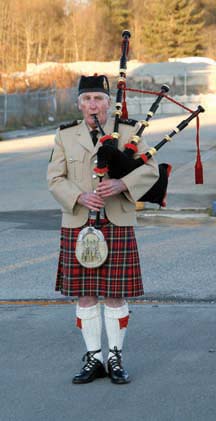
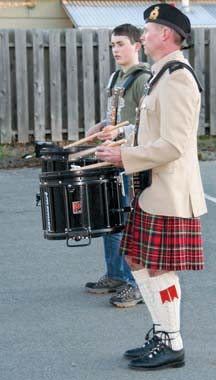
If the skirl of the pipes quickens your pulse, consider joining our group. Pipe Major Ian Richmond, at 604 483-9673, says they seek members with some talent or musical potential, especially drummers! The Clansmen offer free instruction, free uniforms and instruments and camaraderie. The bank particularly seeks neophyte drummers.
Moose Club alive and well
Thriving under new organization
The Powell River Moose Club is thriving since its separation from Moose International, says the executive of the local organization.
Since 1948, the Moose Club has been active in Powell River, but until recently was associated with the Loyal Order of the Moose International. But a declining membership, disagreements over having women as full members, and an increase in the amounts that the international organization was taking from membership dues prompted a split.
“We were struggling to make ends meet,” said the local club president, Brad Wilson. “People here had worked really hard to support the community and sent money to the States. We were concerned about our ability to support the local community “
Separation was a “last resort,” said Wilson. “We tried to go through all the hoops.” But in August, the local club separated from Moose International. To try to smooth the transition, life memberships in Moose International were honoured in the Powell River Moose Club. Old Moose International memorabilia was handed over to former members or donated to the museum, to ensure the legacy of the Loyal Order of the Moose. The split was not entirely amicable, and some members left, but in general the club is on the rebound.
Membership had been as low as 240 prior to division, and is now back up to 300.
Much is the same with Moose. The focus remains on youth groups and seniors. They still host candlelight dinners as fundraisers. They still rent or donate their building on Joyce Avenue as a location for groups to host events and fundraisers. And club members and their guests still gather for meals and drinks in the social quarters in the basement of the Joyce Avenue building. It’s open Monday to Thursday from 1 to 8:30 pm, Friday and Saturday noon to 11 pm and Sunday from 1 to 8 pm. Fish and chips are served Wednesdays and steaks on Fridays. On a regular Friday, the place will host 20 to 30 people. When there’s a band, there’s a waiting list to attend. It employs two full time and three part-time staff to run the social quarters and maintain the building.
Changes to the club include the inclusion of women as voting members—there are four on the executive. They’re also beginning to draw a younger crowd. “It appeals to all ages,” says club treasurer Laurie Derby.
The biggest change is the hyper-local focus of the club. Ten per cent of the membership dues are donated back the community. To get help from the Moose Club, it’s a simple matter of sending a written request, which the board discusses. Sports teams, therapeutic riding, Special Olympics, the fireman’s burn fund and Children’s Hospital are among the groups that have received donations recently.
“We’re keeping on that and picking up the pace,” said Wilson.
The club hopes to resume bingos soon, which can be a big fundraiser. But they’re also hoping to do more “fun things for fundraising,” said Wilson.
The Moose have a history of doing fun events, and the local club plans to continue those events. Their Halloween party was evidence of that. And they will continue to help other local charities by providing a place for fundraising events, as they have recently with the Brain Injury Society, Girl Guides and Antique Car Club. Their hall seats as many as 200, and has full kitchen facilities, with four ovens, grills, fryers and so forth. Hall rentals also contribute to the funds the club has to share with the community.
| Moose Club Executive | |
|---|---|
| Brad Wilson, President | Laurie Derby |
| Jeanette Shaw | Sandy McAlpine |
| Clark Banks | Evelyn Sturam |
| Jay Yule | Ted Tunstall |
| Al Drummond, Manager | |
Moose Village changing owners
The eight-unit Moose Village in Cranberry is being sold to Lifecycle Housing. “It’s sad to see the change,” said Moose Club president Brad Wilson, “but it’s positive for the tenants.”
The units need upgrades that would have been costly for the Moose Club to make. Lifecycle already has 31 units on Ontario Avenue and another 12 at Brew Bay. “It gives the Moose Club a stable footing and it puts the homes in good hands,” said Wilson.
The Moose Village name will be kept.
Locally created and managed portal
A community calendar, and more, by the community
By Roger Whittaker
Powell River Direct (www.powellriverdirect.com), a web portal, is designed and directed by Norah LeClare, who moved to Powell River with her husband James in the summer of 2005 as the result of a series of serendipitous events.
What happened to the LeClares will be very familiar to anyone who has ventured into the Sunshine Coast/Langdale lane at the ferry terminal at Horseshoe Bay. It is as if a spirit other than your own picks you up by the ear and drags you toward a new destiny, and you go because you appear to have lost your ability to choose and for once, the voices have their way with you.
Arrival in Powell River opened Norah up to a new way to live. She coupled her new life with her considerable research and project execution skills to create an understanding of her new community. Powell River Direct is the result, a locally designed and managed web portal where residents and visitors alike can divine activities and access the up-to-date event calendar at the click of a mouse.
Similar event- and activity-focused publications exist for residents of Malaspina Peninsula, Texada and surrounding area, but Norah hopes to differentiate Powell River Direct from the rest by making the event calendar self-posting so persons in charge of events can simply post updates and event information as it is created and evolves.
Norah created a calendar featuring events two years into the future so persons planning an event can intentionally include or carefully avoid overlap.
More than simply a place to promote events, Powell River Direct promotes Powell River, Lund, Texada and surrounding areas to the worldwide audience.
Business owners, who often provide the space and dollars toward the success of an event, can now simply present the non-profit event as taking place at their location; moreover, events created on the fly can be included in Powell River Direct.
More than an event calendar, Powell River Direct has a community page with regional photos, portals to everything from Lund community information to suicide hotline contact numbers. It also provides links to local government structure and meeting times, maps of the entire area with detailed directions to event locations and venues, direct links to the many arts groups, cultural drivers, recreational opportunities, and even a free discussion board.
These are certainly times of great change. Businesses, which once relied on their main street front door, are discovering customers enter through cables and telephone lines. Event organizers have their dreams of a well-publicized event barking to the world come to fruition through the power of the Internet. Who knows? Maybe one day a Chicago marathoner will come to the Bruce Denniston Spirit Run and well-informed ocean divers will check into the Lund Hotel, seeking to realize their own dreams—dreams opened up in their minds by a journey made to Powell River first through the portal of Powell River Direct.
Powell River Direct is supported, in part, by Powell River Chamber of Commerce, The Arts Council, Powell River Regional Economic Development Society and Tourism Powell River.
Henderson means heritage and heart
“When it comes to community spirit, think Henderson,” says Kindergarten teacher Janice Taylor. “We have a lot of traditions, some old, some new, here at our school spearheaded by many different people.”
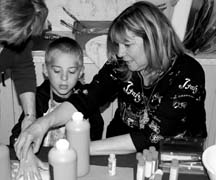
Pockets of school wide initiatives are practiced in the classroom. For instance Henderson is a “green” school. As well as school wide recycling, the Kindergarten room has reusable “snack mats” (placemats) for snack time. “We have cotton cloths to wash mats and towels to dry hands. Reusable vinyl tablecloths are used for parties. My Kindergarten students wash out their own pudding cups, fruit tins and plastic bags. We are responsible for taking care of the earth.”
Taylor grew up in Powell River but moved away as a young woman. She and her teacher/musician husband Peter moved back to Powell River in 1994. “One day, I filled in for Jacque Scholtz’s Grade K/1 class and since that time I have been at Henderson!” she laughs. Coming home brought back a flood of memories for Taylor. “I went to Kindergarten at the little Grief Point Sunday school. Mrs. Padgett was my teacher and Mrs. Churchman was her assistant. When I attended Grief Point Elementary Shirley Ellingson was my Grade 3.” Taylor remembers when Miss Ellingson (again, her grade 5 teacher) got married, she invited all her students to the wedding at the Westview United Church. “Now Shirley Cole lives two doors down from me.”
Taylor moved away, attended UBC and taught in Langley. She and her husband have two children and now both their children have moved back to Powell River. “My son is an auto technician. My daughter has a degree in education and was a teacher-on-call here the other day,” she said.
Taylor teaches Kindergarten and has spent most of her career teaching the primary grades. “At one time I thought I’d like to have a third child—and then I got a Kindergarten class. Working with these wonderful little children filled the void.”
There are many things Taylor loves about Henderson including the Restitution process to deal with behavioural issues. “At carpet time we problem solve. Students learn that every behaviour is driven by a need. There are basic needs such as power, love and belonging, freedom and fun. If, for example, a power need is not being met, sometimes students will bully. We talk about how the person feels when he is being bullied, as well as how the bully is feeling.” We discuss ‘up and clean power’ (ways to feel empowered) as an alternative to ‘down and dirty power’ (bullying). We talk about inclusion versus exclusion. There is always a bottom line with the restitution process. There are consequences, followed by the offender ‘making it right.’”
Taylor’s Kindergarteners sign a classroom contract each year. Our current contract reads, “We are safe. We are friendly.” When behaviours are unravelling, we refer to the contract by asking the students involved “What do we believe?” We also have a poster of what a safe classroom looks like. It included words such as peaceful, sharing, helping. Other words, such as kicking, yelling hitting and hurting are used to describe what children don’t want to see happen in their classroom.
Both ACCESS (Animals for Community Care and Emotional Support Society) dogs and Brain Gym help ‘center’ students, says Taylor. “A lot of the brain gym exercises we do enhance learning.” The Roots of Empathy program is implemented in our Kindergarten program. We observe how babies are feeling as we learn about reading body language. “If you can start making young children aware of others’ feelings, it makes them more empathetic human beings.”
“The other big plus I find in our school is our principal, Jamie Burt, who is known to kneel in order to look young students in the eye and talk to them. He has a great sense of humor which makes Henderson a happy place to learn and work! Our secretary, Pat Good (also a Support Service Assistant), brings her ACCESS dogs to school. The faces of our students light up when Ms. Good and Ace or Towhee show up!”
It is not surprising that Taylor incorporates music into her lessons. “I love to strum on the guitar and incorporate music into literacy and math. There are so many things you can do with music. Music soothes young people, so when kids are getting a little too excited, music calms them down.”
Henderson is such a special school. “We are proud of our Breakfast Program, first initiated by two previous administrators, Jacque Scholtz and Bill Bailey. We are grateful to the people who continue to donate food or funds and those who volunteer in our kitchen on a daily basis. No student ever goes hungry at Henderson. It has the spirit of a shared community. We have a Strong Start program at our school and we invite people from the community such as Betty Wilson, Jack Vlug, Ms. Maria and many others, to share their gifts and talents with students. Our Kindergartens are fortunate to have Marion Smith showing them how to make a handprint quilt,” said Taylor. “If we can include the community, we are much better off.”
